Large Scale Mining
Angkor Gold's Cambodia Projects
May 2013 by Leonard Melman
Several nations around the world are working diligently to make their countries more attractive to resource development as a means of improving economic development. One such nation is Cambodia, located west of Vietnam, south of Laos and due east of Thailand. World Bank estimates that Cambodia’s economic growth rate will reach 8.0% for 2013. Canadian junior miner Angkor Gold Corp. is working to take advantage of this current favorable environment as well as Cambodia’s favorable growth prospects.I had the privilege of touring Angkor’s Cambodian projects in late March in the company of several other analysts and had the opportunity to talk with Angkor’s President and CEO, Mike Weeks. When asked about reasons for Angkor’s becoming the first North American mining company working in Cambodia he replied, “…Angkor has a first-mover advantage. Cambodia is a country in which doing business is encouraged and supported by government. As it happens, I also love the people and the country.”
When it comes to mining, the Cambodian government has attempted to simplify and speed up the regulatory process by modeling their general minerals policy after mining-rich Australia.
During our visit, we met with two lawyers active in Cambodia corporate law, Vathana Sar and Rashed Idrees.
During a meeting lasting over an hour, they pointed out that one important goal of Cambodian lawmakers was consistency of law, particularly for the mining ministry, which has seen permit applications grow from about 15 applications five years ago to over 70 today. The lawyers stressed that one important concept is that once permits have been granted, those projects should be required to move steadily forward, rather than simply be held in some sort of corporate inventory.
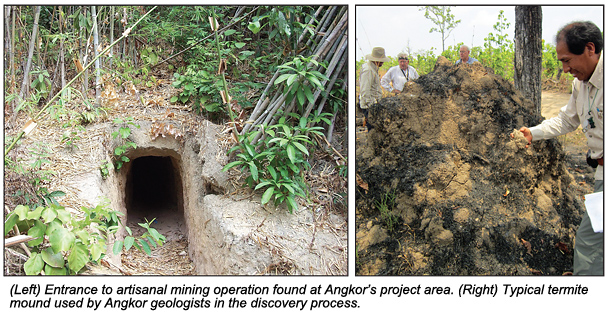
Cambodia has advanced far beyond the terrible Khmer Rouge years of death camps and “killing fields,” and strong, democratic government has now been in power for more than 20 years. They have steadily improved their infrastructure and while traveling well over 700 miles of road during our visit, we could see numerous road improvement projects underway. These projects have reduced the driving time from the capital of Phnom Penh to the community of Ban Lung adjacent to Angkor’s project areas from two days to only six or seven hours, with more improvements scheduled.
Given the country’s high annual rainfall, adequate water supplies are readily available, but electricity can be a problem as the major inflow of electric current comes from nearby Vietnam and that source can be interrupted for several hours at a time.
There is a genuine division within the meteorological year between the dry, hot season, which lasts from November through April, and the wetter but somewhat cooler monsoon period that lasts from May through October. There is a risk of flooding during the wet months, particularly when major dams in Vietnam find it necessary to release vast quantities of water that flow directly into northern Cambodia.
Angkor’s project areas cover a total of five tenements (or concessions) named Banlung, Banlung North, Oyadao, Oyadao South and Andong Meas, plus three more tenement areas where exploration license applications have already been filed. Those three areas are named Siem Panh, Trapean Kraham and Koan Nheqak. The combined total of the company’s areas of interest is about 1,800 square kilometers.
The company’s focus is aimed in three specific directions. First, they plan to continue conducting sufficient exploration work to develop interest in some of their vast holdings to attract joint venture offers specifically including up-front cash payments. Second, where feasible, they plan to construct such joint ventures to include
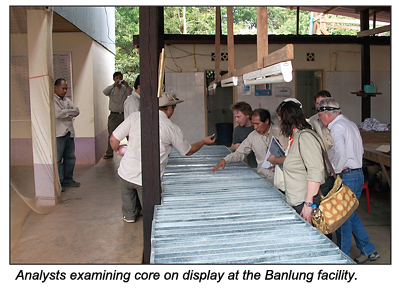 Net Smelter Returns on future productions with the goal of establishing future reliable cash flow. Third, the corporate plan is to use such revenues for further development of their own exploration projects.
Net Smelter Returns on future productions with the goal of establishing future reliable cash flow. Third, the corporate plan is to use such revenues for further development of their own exploration projects.Clearly, in order to efficiently work toward the first goal, a cost-effective and time-saving method of establishing mineral potential would be invaluable, and Angkor has turned toward a relatively new technique—that of analyzing samples from termite mounds that proliferate across many of their holding areas. During our travels in northern Cambodia, we saw literally hundreds of them.
Termite mound analysis is actually a well-known method that has been documented with some degree of success in both Africa and Australia. One geologist, Ambogo Guindo of Mali, Africa reported that, “…In search of water, termite colonies can burrow as deep as 80 meters (265 feet) underground, depending on the hardness of the rock and the depth of weathering, and transport material along the way to the top layers of the mound. If they dig through important mineralization on their way down, this will typically be represented in a series of mound samples.”
In a paper published in National Geographic News, researchers in Australia also reported that termite droppings recovered from these mounds could indeed be valid indicators of mineral values. Like virtually all living creatures, termites require water to live and, during dry seasons, they burrow down through varying material in order to reach the water table, digesting whatever material they encounter along the way. The droppings from this material, which can be recovered from the surface of these mounds, can then be examined for metals values via spectrometer analysis.
The article points out that, “…By using a mass spectrometer—an instrument that measures molecules’ chemical makeup—they discovered that… insects could essentially act as indicators of buried treasure.”
An evaluation of a new area using common techniques such as grab-bag sampling, soil and geochemical analysis, and Induced Polarization (IP) studies could take three months or longer before preliminary results might be obtained. The great advantage for Angkor is that by using spectroscopic analysis of termite mound material, the same project evaluation progress can be accomplished in as little as three weeks.
Other valuable indicators of potential economic mineral values include widespread evidence of substantial past artisanal mining activity by local citizens that dates back to Cambodia’s colonial eras, evidence of alluvial gold throughout many areas of the company’s holdings, and data gained from Angkor’s rock chip sampling and trenching activities.
To date, Angkor has completed two working agreements. An Indian company, Mesco Gold Ltd., has signed an agreement calling for cash payment of $1.2 million and future production royalties of 10% in order to develop
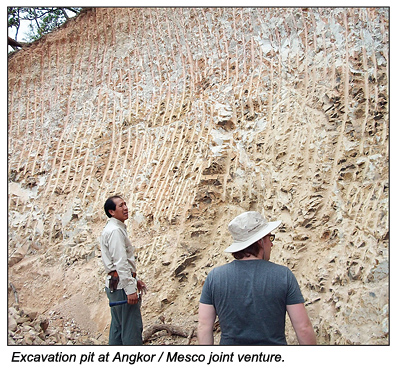 and mine Angkor’s Phum Syarong (PS) prospect located within the Oyadao South Concession. Angkor conducted extensive development work at PS including 19 drill holes over 1,990 meters at a cost of about $500,000 before announcing the Mesco agreement. Additional drilling work at PS has recently taken place and the company is assisting Mesco in order to initiate production at the earliest possible time. According to the most recent estimates, Mesco aims to be in production by late 2014.
and mine Angkor’s Phum Syarong (PS) prospect located within the Oyadao South Concession. Angkor conducted extensive development work at PS including 19 drill holes over 1,990 meters at a cost of about $500,000 before announcing the Mesco agreement. Additional drilling work at PS has recently taken place and the company is assisting Mesco in order to initiate production at the earliest possible time. According to the most recent estimates, Mesco aims to be in production by late 2014.The other agreement is with a private Chinese company, “All Solutions (Cambodia) Ltd.,” and involves the sale of a 78 sq km section of the Oyadao tenement for cash payment of $2,400,000 with Angkor retaining all rights to the remaining 222 sq km of the Oyadao license.
Angkor’s own project areas include the Dokyong Project where strong soil anomalies have generated several drill targets and exploration is being conducted in an attempt to identify a 10 km shear fault zone, which would connect Dokyong to the Mesco-PS Project.
In addition, company geologists are actively exploring their Okalla Project, located in the Banlung tenement, where the company is working to confirm a large-tonnage copper-gold-molybdenum porphyry system. To date, 33 drill holes covering 5,461 meters have been drilled, with a further 1,400 meters scheduled for later this year.
Going forward, plans include further assistance to the Mesco-PS Project; advancing mapping and infill exploration to advance Dokyong, Okalla and other company properties; as well as continuing the search for additional joint venture partnerships, specifically focusing on those companies that will work aggressively to advance projects toward production.
One important company function is the entire realm of sustainable community relationships. Among the goals set out for these relationships are identifying factors to improve health, education and economic standards for area communities; improve clean water facilities in the region; give area village people stronger control and responsibility for their own development; and provide training and workshops on project management, planning, monitoring and evaluation techniques.
Given that area poverty is widespread and unemployment remains near 60%, the company hopes that their community involvement will lead to significant improvements in the area people’s quality of life. As VP-Corporate Development Fletcher Morgan noted, “We strongly believe our community support actions are the right thing to do and are a key part of our social license to operate. The locals are stakeholders in our success and we welcome their active participation.”
Angkor’s management team is headed by President and CEO Weeks; Chief Operating Officer Scott Donahue; VP Corp. Development Dr. Fletcher Morgan; Country Manager J. P. Dau; VP CSR Delayne Weeks and Special Advisor Richard Stanger, also President of the Cambodian Mining Association.
_______________
Further information is available at www.angkorgold.ca or contact Fletcher Morgan via email at fm@angkorgold.ca 
The ABCs of XRF
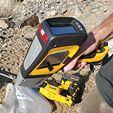 Fast forward to present day and the XRF has come of age. Pull the trigger on the hand-held device and you get a nearly instant assay of the surface of a rock.
Fast forward to present day and the XRF has come of age. Pull the trigger on the hand-held device and you get a nearly instant assay of the surface of a rock.
The Mysterious Telluride Minerals
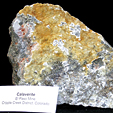 …let’s dive in and take a closer look at these rich gold and silver-bearing minerals to find out what they are, where they form, and how to identify them.
…let’s dive in and take a closer look at these rich gold and silver-bearing minerals to find out what they are, where they form, and how to identify them.
Care and Lubrication of a Model 13 Laboratory Wilfley Table
 A Wilfley table works best when all of the mineral being run across it (the pulp) is about the same size. For this reason, I took a good look at each of the samples.
A Wilfley table works best when all of the mineral being run across it (the pulp) is about the same size. For this reason, I took a good look at each of the samples.
Caught Between A Hard Rock and A Rare Earth Place
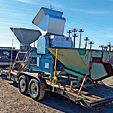 The same day, while two of us were heading to Vancouver to attend the mining convention, two others from our team were headed to Nevada to begin loading the millsite equipment.
The same day, while two of us were heading to Vancouver to attend the mining convention, two others from our team were headed to Nevada to begin loading the millsite equipment.
Reminder: Annual Claim Filings Due
Please note that new mining claims filed on or after September 1, 2019, will be subject to the new fee schedule.
The Snapshot
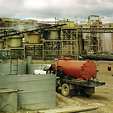 Once all the numbers from all the samples and water tests are compiled, a snapshot of the performance of each tank in the process circuit can be seen side-by-side.
Once all the numbers from all the samples and water tests are compiled, a snapshot of the performance of each tank in the process circuit can be seen side-by-side.
Company Says Central Idaho Project Feasible
...the federal agency is intrigued by a plan that might result in cleaning up the area without cost to taxpayers.
Subscription Required:
The Bawl Mill
• Gold Rush in the Congo
• Find of a Lifetime
• All About Quartz—Part I
• Over the Divide
• Your Guide to Prospecting in Alaska
• Shallow Water Crevicing Can Bring Big Rewards
• A Father and Son Prospecting Adventure
• Home Office Deductions
• Advantages of Modern Prospectors
• Searchers' Dreams
• Gold in Unlikely Places
• Melman on Gold & Silver
• Mining Stock Quotes and Mineral & Metal Prices
Free:
Legislative and Regulatory Update
• Contact Information for Oregon Senators








